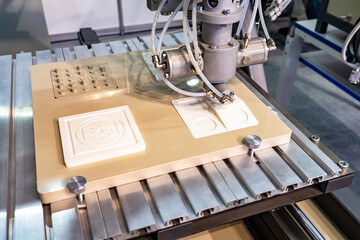What is selective laser sintering? In the world of 3D printing, technological advancements have opened up new possibilities for manufacturing and design. One such advancement is Selective Laser Sintering (SLS), a technique that has revolutionized the way objects are created using additive manufacturing.
In this discussion, we will explore the intricacies of SLS laser, its advantages over traditional 3D printing methods, and its wide range of applications across various industries.
Understanding the Selective Laser Sintering Process
Selective Laser Sintering technology is a 3D printing technology that uses a high-powered laser to selectively fuse powdered materials together, layer by layer, to create a solid object. Unlike other techniques that rely on melting or extrusion of materials, SLS works by heating the powdered material just below its melting point, causing it to fuse together.
The SLS process can be broken down into three main steps:
- Material Bed Preparation: A thin layer of powdered material is evenly spread across a build platform.
- Laser Scanning and Fusion: A high-powered laser scans the cross-section of the object being printed, selectively fusing the powdered material together based on the digital design.
- Layer-by-Layer Building: The build platform lowers, and a new layer of powder is added on top. The laser then scans and fuses the next layer onto the previous one. This process is repeated until the entire object is formed.
Compared to other 3D printing techniques such as Fused Deposition Modeling (FDM) and Stereolithography (SLA), SLS offers several advantages, including greater design freedom, the ability to use a wide range of materials, and improved cost-effectiveness and time efficiency.
Advantages and Benefits of Selective Laser Sintering
Increased Design Freedom and Complexity
SLS allows for the creation of highly intricate and complex geometries that would be challenging or impossible to achieve with traditional manufacturing methods. The layer-by-layer nature of SLS enables the production of intricate internal structures and moving parts within a single print.
Utilization of a Wide Range of Materials
Unlike other 3D printing techniques, SLS can use a variety of materials, including polymers, metals, ceramics, and composites. This versatility opens up endless opportunities for different industries to create functional and customized parts.
Cost-effectiveness and Time Efficiency
SLS eliminates the need for support structures, as the unsintered powder acts as its own support during the printing process. This reduces material waste and post-processing time, making SLS a cost-effective and time-efficient sls additive manufacturing method.
Reduced Waste and Environmental Impact
SLS generates minimal waste, as unused powder can be recycled and reused for future prints.
Additionally, the ability to consolidate multiple parts into a single print reduces the overall material consumption and energy usage, making SLS a more sustainable option.
Applications across Various Industries
Selective Laser Sintering 3D Printing finds applications in diverse industries such as automotive, aerospace, medical, consumer products, architecture, and art. Its versatility and ability to produce complex parts make it suitable for prototyping, functional components, and even end-use parts.
Material Considerations for Selective Laser Sintering
Overview of SLS-Compatible Materials
Normally, a selective laser sintering 3D printer can utilize a wide range of materials, including thermoplastics, nylons, metals, ceramics, and even glass-filled materials. Each material offers unique properties, such as strength, flexibility, heat resistance, and conductivity.
Properties and Characteristics of Commonly Used SLS Materials
When using a sinter 3D printer, Nylon-based powders, such as PA12 (polyamide 12), are commonly used in SLS modeling due to their excellent mechanical properties, high heat resistance, and chemical resistance. Other materials, such as metal powders (e.g., aluminum, stainless steel), offer enhanced strength and durability.
Emerging Materials and Their Potential Applications
Researchers and material scientists are constantly exploring new materials for laser sintering 3D printer, such as biodegradable polymers, conductive materials, and bioactive materials for medical applications. These advancements open up new possibilities for various industries.
Limitations and Challenges of Selective Laser Sintering
- Constraints in Part Size and Resolution: SLS has limitations in terms of part size and resolution. Large parts may require multiple printing runs or be subject to reduced accuracy. Achieving fine details and smooth surface finishes can also be challenging.
- Surface Finish and Post-Processing Requirements: SLS parts typically have a rough surface finish, requiring additional post-processing steps such as sanding, polishing, or coating. Depending on the application, these additional steps may be necessary to achieve the desired aesthetics and functionality.
- Equipment and Operational Costs: SLS machines and materials can be expensive, making it more suitable for industrial-scale production



